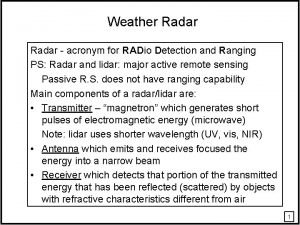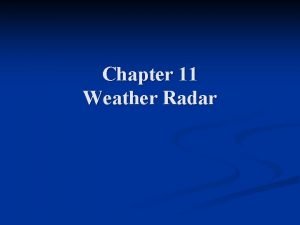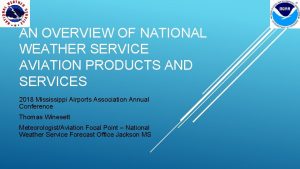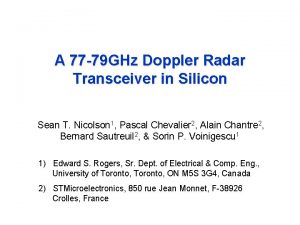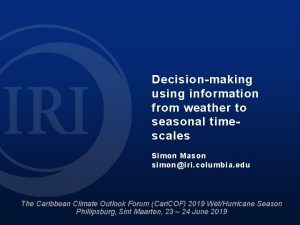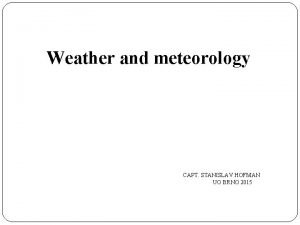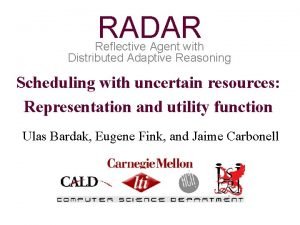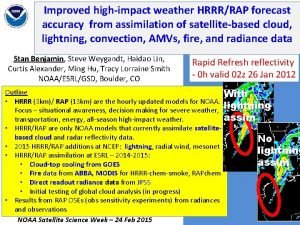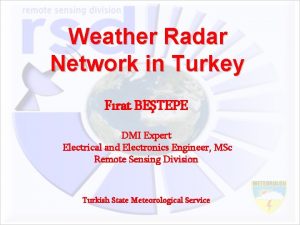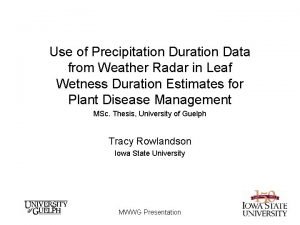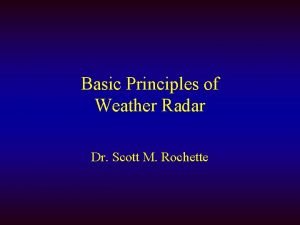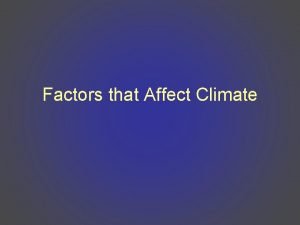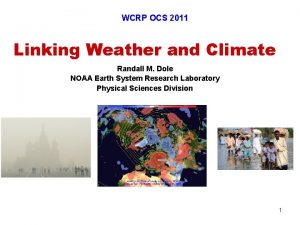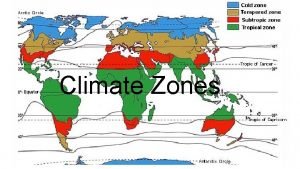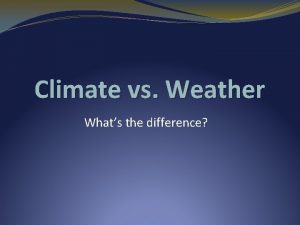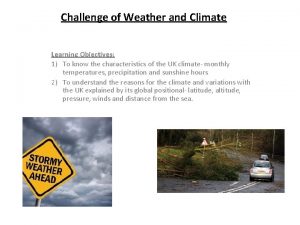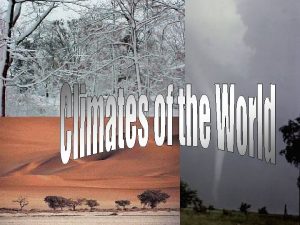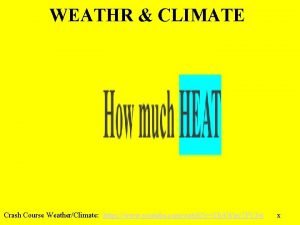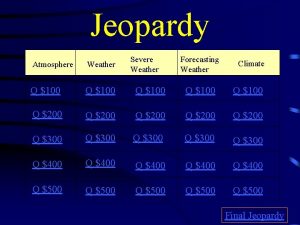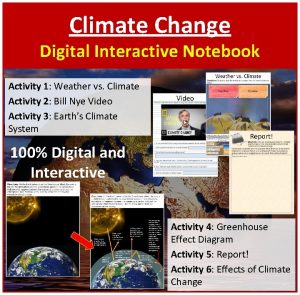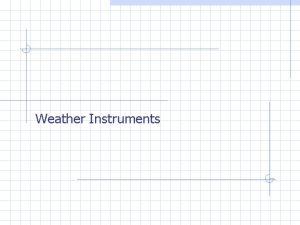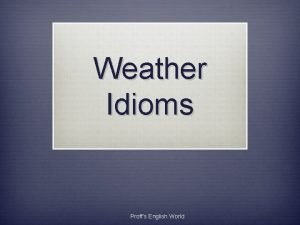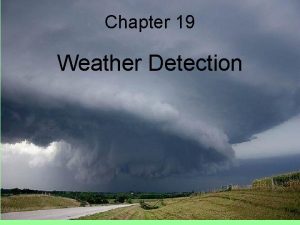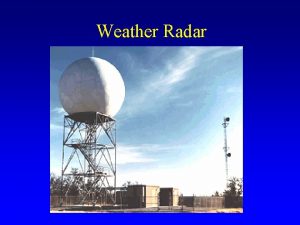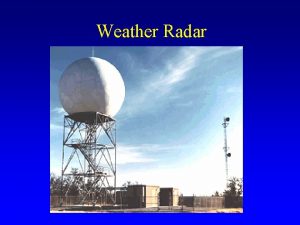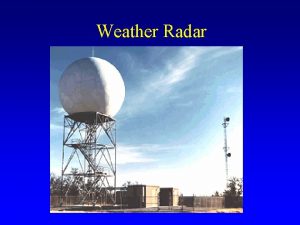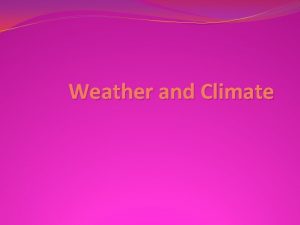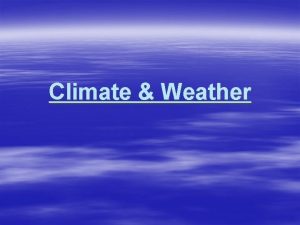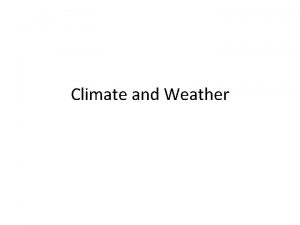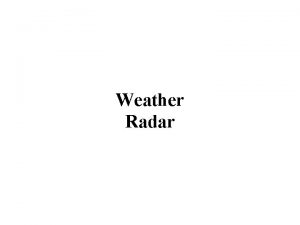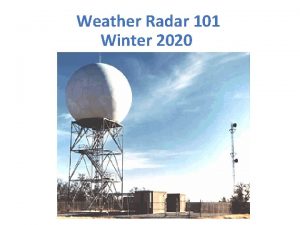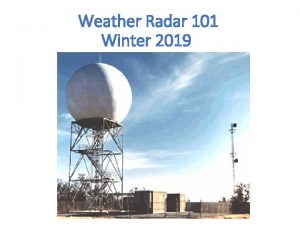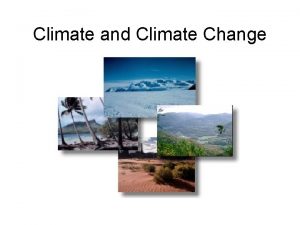Representing Climate Data continued Weather Radar radar Radio































- Slides: 31

Representing Climate Data (continued) Weather Radar

radar (Radio Detection and Ranging) Allows us to look inside of clouds and “see” types of precipitation.

• A transmitter sends microwave pulses. • “Targets” scatter energy back to receiver. • Amplified and displayed as echo • Time between emitting energy and receiving it back from target tells distance to target.

• Shorter microwavelengths (~1 cm) • detect small targets • (e. g. , tiny droplets of water in clouds) • Longer micro-wavelengths (3 -10 cm) • detect larger targets • (e. g. , precipitation) • Brightness of echo • Amount of precipitation





Reflectivity units d. BZ : decibels of Z • “Z” is energy reflected back to radar • Values increase with strength of signal and intensity of ppt Two Modes: 1. Clear air 2. Precipitation • d. BZ equate to approximate rainfall rates

Clear Air Mode

Precipitation Mode

• Makes repeated 360˚scans of atmosphere at increasing elevation angles. • 2 modes: • Clear Air mode • No rain • Dust, light snow • VCP 31, 32, 35 (volume coverage pattern) • Precipitation mode • Rain or snow • VCP 12, 215

Ground clutter • Ground, buildings, trees, cars • Within 25 km of radar • Not moving with respect to radar, so can be detected by radial velocity • Insects • Birds • Turbulence • Effects density • Particulate Matter

Doppler Radar • Based on principle of Doppler shift: • Waves moving towards observer have different frequencies than waves moving away from observer. • e. g. , sound from approaching vs. leaving ambulance • Doppler radar can measure direction • Knowing wind speeds and directions within clouds gives info about vorticity (spin)



Velocity units • Radial velocities in knots • Red: wind moving AWAY • Green: TOWARD radar • Need to know where radar is!





Base reflectivity • Reflectivity in lowest elevation “slice” • Used to survey area close to radar

Composite reflectivity • Combines all elevation scans • Shows highest reflectivity

Dual-Polarization radar • Conventional radar receives pulses in horizontal directions. • Dual-pole : horizontal and vertical • Get a better picture of what exactly the targets are: hail, rain, snow, melting snow, insects!

Example of use of dual pole radar: can detect hail

Example of tornadic debris ball using dual pole

RIDGE (Radar Integrated Display with Geospatial Elements) • Combine radar with topography, roads, county lines, rivers, warnings • Overlay maps as layers • Toggle layers on or off • GIS compatible NWS Duluth

Links to interesting and helpful short videos: 1. BATS in Texas were detected on weather radar: Check this out! Full link: https: //weather. com/science/weather-explainers/news/2020 -03 -20 radar-strange-cool-things-bats 2. Take a tour inside the “giant soccer ball” to see what’s inside: Tour the radome! Full link: http: //hot 1047. com/go-inside-a-doppler-radar-with-the-national-weather -service-video/ 3. Have a look at the latest radar technology: dual pole Dual pole Full link: https: //www. youtube. com/watch? v=Qdv. AODg-lts

REVIEW • Geostationary and polar-orbiting satellites • Visible satellite imagery: • • • Records albedo Only useful during daylight hours Shows all cloud cover, land/water, frontal systems, snow surfaces Transmitted through shortwave window NEW GOES bands: • BLUE (0. 47µm): good for aerosols • RED (0. 64 µm) : good for snow/ice • Infrared satellite imagery: • Thermal IR • • • Records emitted IR Records day and night Detects temperature Reads cloud height NEW GOES bands: • CLOUD TOP PHASE ( 8. 4 µm): good for cloud composition • CLEAN IR WINDOW (10. 3µm): good for cloud heights

• Near IR Solar; Daytime only Veggie Band (0. 86µm): good for flooding, burn scars, types of vegetation, fog cirrus (not lower troposphere because water vapor absorption) Cirrus Band (1. 37 µm) : good for cirrus clouds, volcanic ash Water vapor satellite imagery: Records infrared at 6. 2 – 7. 3 µ emitted by water vapor Upper, middle, lower troposphere Tracks moisture Shows storm (low) centers Shows jet streams and sinking air Good for observing structure of storms

RADAR: Is an active form of remote sensing because it sends out energy. “target” (precipitation) scatters energy, some back to receiver, which displays it as “echo”. Brightness is intensity of precipitation Two Modes: Clear Air (can pick up ground clutter) and Precipitation d. BZ values: decibels of Z = strength of return signal Doppler : provides direction of targets toward or away from radar. Velocity image : used to identify rotation Dual polarization: can decipher and identify targets better RIDGE: GIS compatible
 Limitations of mti performance
Limitations of mti performance Frequency response of single delay line canceller
Frequency response of single delay line canceller Climate change 2014 mitigation of climate change
Climate change 2014 mitigation of climate change Is radar an acronym
Is radar an acronym Munich weather radar
Munich weather radar Weather radar equation
Weather radar equation Awc weather radar
Awc weather radar Weather radar transceiver
Weather radar transceiver Olney weather radar
Olney weather radar Yahoo weather rss
Yahoo weather rss Uo brno
Uo brno Cbr weather radar
Cbr weather radar Rap weather radar
Rap weather radar Dmiradar
Dmiradar Elora weather radar
Elora weather radar Scott afb weather radar
Scott afb weather radar World geography chapter 3 weather and climate
World geography chapter 3 weather and climate Clim 101
Clim 101 How do prevailing winds affect climate
How do prevailing winds affect climate Weather and climate similarities
Weather and climate similarities Conclusion of weather and climate
Conclusion of weather and climate 12 climate zones map
12 climate zones map Whats the difference between weather and climate
Whats the difference between weather and climate Objectives of weather and climate
Objectives of weather and climate Climate vs weather
Climate vs weather Weather and climate crash course
Weather and climate crash course Weather vs climate crash course
Weather vs climate crash course What single factor controls humidity
What single factor controls humidity Weather and climate jeopardy
Weather and climate jeopardy Weather and climate interactive activities
Weather and climate interactive activities Instruments used to measure weather and climate
Instruments used to measure weather and climate Idioms about weather and climate
Idioms about weather and climate



